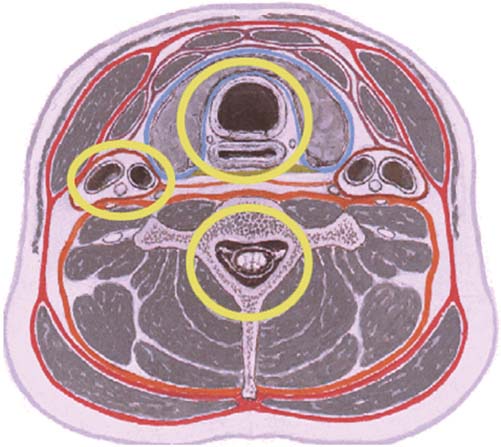9 Complications in Percutaneous Endoscopic Cervical Diskectomy The percutaneous endoscopic cervical diskectomy (PECD) is considered a relatively safe procedure because there are not many complications associated with it. Through gradually growing experience, however, we have witnessed a few complications associated with PECD, although they are not frequent. This chapter presents these complications and the measures used to avoid them. • PECD is a keyhole surgery; hence less pain and discomfort are related to the approach. • PECD is performed with greater surgical precision; as a result, there is less trauma to surrounding soft tissues and less blood loss. • Because it is a minimally invasive surgery, there is minimal scarring. • The keyhole nature also reduces the chance of infection. • As already mentioned, PECD is a keyhole surgery; hence the detailed anterior cervical anatomy is not visualized. • The endoscopic images have different orientations from those of open surgery. • Fluoroscopy may lead to errors in judgment regarding surgical instrument positioning inside the disk space. Complications that arise during PECD include neurological injury, vascular injury, visceral injury, and infection. During PECD, it is possible to damage the cervical cord or nerve root due to inadvertent use of forceps under fluoroscopic visualization and the use of forceps or laser in endoscopic visualization that is obscured by bleeding. Excessive use of the laser use can cause transient or sometimes permanent dysesthesias, especially in the narrow region of the foramen (Fig. 9.1). When insertion of the needle is deviated from the midline, there is a theoretical possibility of injuring the contents of the carotid sheath (carotid artery, internal jugular vein, and vagus nerve). During removal of the foraminal disk, the forceps or laser may injure the vertebral artery. The visceral compartment is generally well protected away from the PECD instruments; however, inadvertent needle placement may injure the esophagus, which is a soft structure, highly prone to injury. Fig. 9.1 Diagrammatic view of the neck showing the tracheoesophageal complex (yellow circle at top), the carotid sheath (yellow circle at left), and the intraspinal compartment (yellow circle at bottom). Septic or aseptic diskitis is always a possibility during any procedure on a disk. • Proper patient selection
Why Percutaneous Endoscopic Cervical Diskectomy Has Fewer Complications than Anterior Cervical Discectomy and Fusion
Why Complications Arise during Percutaneous Endoscopic Cervical Diskectomy Despite Its Advantageous Features
Complications
Neurological Injury
Vascular Injury
Visceral Injury
Infection
Avoiding Complications
General Measures
Stay updated, free articles. Join our Telegram channel

Full access? Get Clinical Tree



